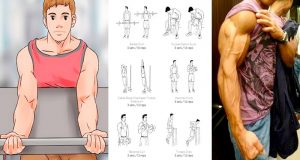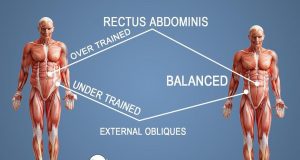Many advances have been made in energy, health, technology, and other areas of life. In strength training, not so much! Stop trying to be original. Tap into the wisdom of our strength forefathers and start getting results! Why pave a new path when there’s already a good one to follow? Here are two routines inspired from the past to begin your journey.
The Stage Routine
Front row and center for quick size and strength gains!
This training system was popular with legendary Canadian strongman, Doug Hepburn, who was considered to be the strongest man in the world at his peak. It will help advanced trainees break through strength plateaus in a short period of time.
The routine involves only 2 exercises per workout and 2 stages per exercise for size and strength gains. Stage 1 will increase relative strength and Stage 2 will induce functional hypertrophy (i.e. muscle mass that produces high levels of strength).
Take a look at the program but don’t blink because it will go by pretty quick!
Day 1 – Chest and Biceps
A1) Flat Barbell Bench Press
A2) Standing EZ-Bar Curls
Day 2 – Legs
A1) Front Squat
A2) Lying Leg Curl
Day 3 – Back and Triceps
A1) Wide-Grip Sternum Pull-Ups
A2) Standing V-Bar Pressdowns
Stage 1: 8 x 1 @ 50X0, 100″
Stage 2: 5 x 5 @ 40X0, 90″
Note: Start with a 3RM load for Stage 1 and a 7RM load for Stage 2.
I suggest that you use the first workout to find your true 3RM (repetition maximum) and 7RM loads, then commence the stage method the next workout. Only increase the weight when all reps for that stage have been successfully completed. The key is to be successful, so leave a little in reserve at the beginning.
Make sure to warm-up thoroughly by using several sets of low reps (5 or less) with progressively heavier loads until you reach your working weight.
This program will last a month. Each workout is performed once in a 5-day period (i.e. Day 1 – Day 2 – Off – Day 3 – Off) for 6 workouts then switch to a new routine. As mentioned above, the first workout is used to find the correct training weight. The next 4 workouts will incorporate the stage method – you should peak on the 5th workout with a new one-rep max on all lifts.
Taper on the final workout by performing only 3-5 sets of as many reps as possible at a 20X0 tempo resting 90 seconds between sets with the original 7RM load. You should notice an increase in number of repetitions performed at that weight. Most people will decay by 1-2 reps per set. Terminate the exercise if you hit 5 sets or drop 3 reps from one set to the next. This will be a short workout. Get in; do your thing; and get out. You may be tempted to do more. Don’t!
If you have been plagued with injuries and are apprehensive to perform maximum singles, stick to the 2-3RM range for Stage 1 and 5-7RM range for Stage 2. The program will work just as well.
Also, you’ll notice that all “A1” exercises are multi-joint movements and all “A2” exercises are single joint movements. Many people are concerned about maximum singles on isolation movements. Listen, either you lift the weight or you don’t, but if it’s still an issue, then substitute a compound movements instead:
Standing EZ-Bar Curls -> Close-Grip Chin-Ups
Lying Leg Curl -> Bent-Knee Deadlift or Snatch Podium Deadlift
Standing V-Bar Pressdowns -> Parallel-Bar Dips or Close-Grip Bench Press
Do not be fooled by the low number of exercises and the low number of repetitions. Many times, less is more and this routine is no exception! The high intensities used for a large number of sets produces great results. Rest assured that the whole body is trained – and trained hard – with this program.
Isometronics
The secret strength and muscle building system of the past and present!
This routine utilizes partial movements and static contractions to break through training plateaus. Partial movements are excellent to shock the system when stagnation occurs – they help to disinhibit the nervous system – and isometrics are great to gain strength at specific joint angles.
In the 1960’s, isometronics (a blend of isotonic and isometric contractions) were promoted as a new secret strength and muscle building system. A couple decades later in his book, The Development of Physical Strength, Anthony Ditillo declared that “isometronics can make you a superman!” Ditillo believed that combining heavy, intense muscular exertions and isometrics in a power rack was “the most potent tool available for increasing physical strength.”
The system is just as effective today as it was back then.
I picked up many of the details of this method in the mid 90’s from strength and conditioning coach, Charles Poliquin, who is a strong believer of using the power rack to promote rapid strength and mass gains. According to Poliquin, the average intermediate bodybuilder can expect to beat his personal records in the curl by 10-25 pounds, and in the close-grip bench press by 30-45 pounds in only 3-4 weeks with this system!
Let’s take a look at the routine.
Day 1 – Chest, Back and Shoulders
A1) 45 Degree Incline Barbell Bench Press
A2) Mid-Grip Pull-Ups
B1) Braced One-Arm Dumbbell Press (neutral grip)
B2) Kneeling One-Arm Pulldown (neutral grip)
Day 2 – Legs and Abdominals
A1) Back Squat
A2) Lying Leg Curls (dorsiflexed)
B1) Snatch-Grip Romanian Deadlift
B2) High-Pulley Crunch
Day 3 – Arms
A1) Close-Grip Bench Press
A2) Standing Mid-Grip Cable Curls
B1) One-Arm Dumbbell French Press
B2) 45 Degree Incline Dumbbell Curls
Isometronics involve lifting through a partial range of motion usually in a power rack (but not always), and finishing each rep with an isometric contraction. Take a third of the range of motion and do 3 sets at 3 different angles of an exercise for a total of 9 sets.
The order you perform the 3 ranges is important. Pick the heaviest (i.e. strongest) weight angle first:
a) Top -> Middle -> Bottom for Incline and Close-Grip Bench Press, and Squats
These exercises are performed in a power rack for 5 reps per set using a controlled tempo (i.e. 2 seconds to lower the bar, gently and quietly touching the lower pins, and two seconds to raise the bar). Then on the 5th rep, try to rip through the top rack pin for 6-8 seconds. Research from Germany shows that 8-second isometrics are enough. If you can make contact with the upper pin then the weight was too light. If you only have one set of pins in your power rack, then lower the bar just shy of resting on the pins and hold the 8-second isometric there. Make sure not to hold your breath during the isometric action. If you selected the proper load, you should not be able to do another concentric repetition.
b) Bottom -> Middle -> Top for Pull-Ups, Leg Curls, and Cable Curls
For these exercises, you perform 5 reps again using a controlled tempo (i.e. 2 seconds up and 2 seconds down), but this time on the 5th rep, pause for 8 seconds in the middle of the range.
The next workout for that body part will occur 5 days later and involve conventional training using hypertrophy parameters. Continue to alternate between isometronic and conventional workouts for six workouts as outlined below.
Workout #1, 3, 5 – Isometronic Training – A) 9 x 5 @ 2020, 120″ B) 3 x 8-10 @ 3010, 60″
Workout #2, 4 – Conventional Training – A) 5 x 5-7 @ 4020, 90″ B) 3 x 8-10 @ 3010, 60″
Workout #6 – Taper – A) 3 x 8-10 @ 2010, 120″ B) 2 x 12-15 @ 2010, 90″
This form of training will induce deep and severe soreness. It is a quick way to gain size as the isometrics create high tension for fast-twitch fibers leading to hypertrophy. This system is also excellent to boost strength and blast through sticking points, but do not use isometronics often in a training year as it is quite stressful to the nervous system.
 Crossfit Blogger News, Information and Bestselling Products
Crossfit Blogger News, Information and Bestselling Products




